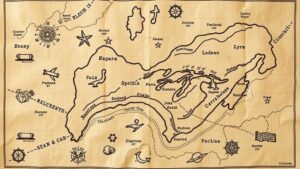Recognizing Code Words or Phrases Embedded in Treasure Map Legends
Recognizing Code Words or Phrases Embedded in Treasure Map Legends
Treasure maps have long been a source of intrigue and adventure, often sparking the imagination of explorers and historians alike. But, the legends that accompany these maps frequently contain coded language, obfuscating the true meaning and required actions to uncover the hidden treasure. Understanding how to recognize and interpret these code words or phrases is crucial for anyone serious about deciphering treasure lore.
The Role of Symbols and Language in Treasure Maps
Treasure maps are not merely geographical representations; they often serve as puzzles that require interpretation. Early cartographers and treasure seekers incorporated symbols, imagery, and coded language to protect their findings from potential thieves or rival explorers. As a result, recognizing code words embedded in legends can reveal directions, identify landmarks, and even suggest the level of danger involved on the journey.
Common Code Words and Their Meanings
Several words and phrases frequently appear in treasure map legends, each carrying significant meaning beyond the literal interpretation. Here are some common examples:
- “X Marks the Spot” – This phrase is foundational in treasure lore, indicating the exact location where the treasure is buried.
- “Beneath the Old Oak” – Often, natural landmarks like trees are key references; the Old Oak signifies a specific, historically significant location.
- “Where the Three Rivers Meet” – Natural topography usually plays a crucial role in directing treasure seekers. This phrase may necessitate consultation of geographic maps for proper identification.
- “Guarded by the Spirits” – Such phrases may imply the presence of natural hazards or challenges to be expected, highlighting the need for caution.
Case Study: The Oak Island Mystery
The Oak Island mystery offers a fascinating case study in recognizing code words in treasure legends. Located in Nova Scotia, Canada, the islands lore is riddled with inscriptions and coded messages that have puzzled treasure hunters for over two centuries. In 1795, a group of boys discovered what they believed to be a treasure site, leading to numerous excavations.
Among the coded legends that have emerged are phrases like the Money Pit and In the Year of the Great Wind. Detailed study of early maps, journal entries, and other associated texts has led to many theories and claims about the treasures nature, suggesting it could involve everything from pirate gold to the lost manuscripts of Francis Bacon.
Decoding Methodologies to Recognize Code Words
Approaching the task of decoding treasure map legends requires a systematic methodology. Several techniques can enhance ones ability to discover food for thought within these puzzles:
- Historical Contextualization – Researching the era when the treasure map was drawn provides vital clues about typical language and symbols used at the time.
- Symbol Analysis – Understanding the significance of symbols can aid in correlating them with specific geographical or historical points.
- Cross-Referencing – Comparing different versions of maps or legends may reveal inconsistencies and help clarify meanings.
- Field Investigation – Visiting the physical locations can provide insights and confirm or refute interpretations.
Pitfalls and Considerations
While the excitement of uncovering a treasure is profound, it is essential to approach treasure hunting with a balanced perspective. Here are a few pitfalls and considerations:
- Over-interpretation – Its easy to read too much into symbols or phrases, turning harmless natural formations into potential clues.
- Legal Implications – Treasure hunting is often hampered by legal boundaries. Ensure you are aware of local laws concerning excavation and discovery.
- Historical Accuracy – Historical documents can provide a misleading narrative; it is critical to consider verified evidence and historical criticism.
Conclusion: Unlocking the Secrets of Treasure Maps
Recognizing code words and phrases in treasure map legends is an art that combines historical research, linguistic analysis, and imagination. By understanding common codes, employing effective decoding methodologies, and navigating potential pitfalls, treasure hunters can significantly increase their chances of uncovering hidden treasures. Always remember that the journey itself can offer rich rewards, even if the ultimate treasure remains elusive.
As you set off on your next treasure-seeking adventure, keep this guide in mind to help decipher the mysteries hidden in legends, ensuring both a rewarding and enlightening experience.



